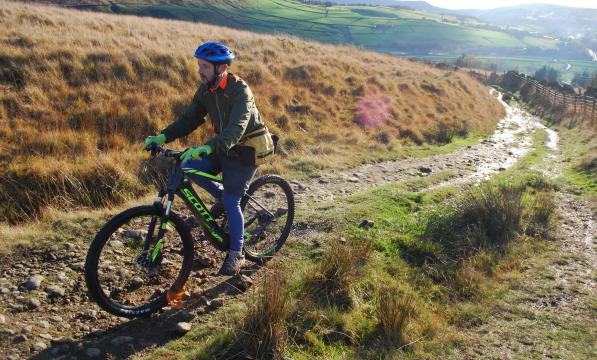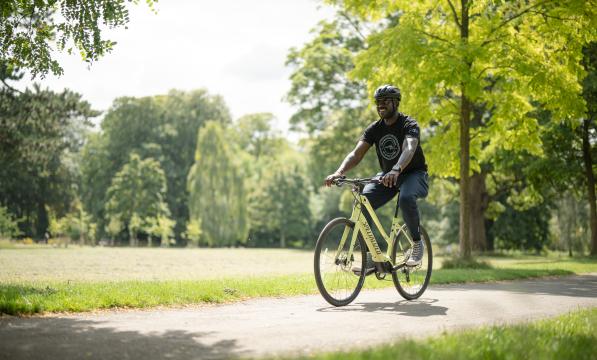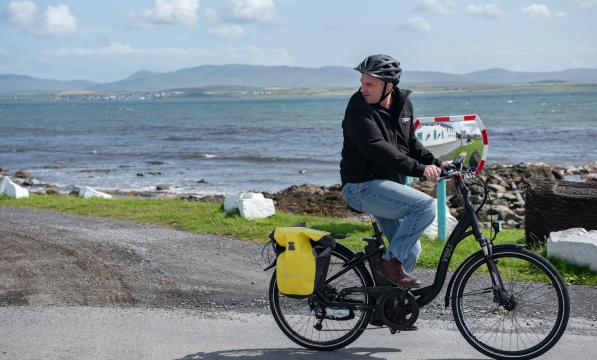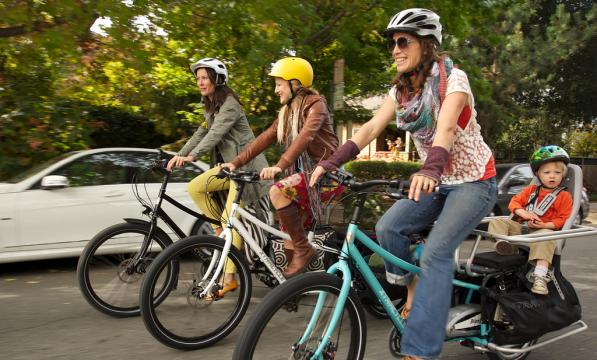Guide to electric bikes and e-cycles

What is an electric bike?
The simple answer is that an electric bike (e-bike for short) is more or less a regular bike with the addition of a motor to assist your progress.
The more complicated answer is that it is a hybrid form of transport meaning part of the power comes from the rider (exactly how much is up to you) and part of it from the motor. This applies up to around 15.5mph which is the current legal limit for electric assistance. Once you are pedalling beyond that speed the motor will not assist you.
You might also hear e-bikes called pedelecs. This is simply another name for e-bikes where the power is activated on pedalling instead of by throttle. The vast majority of today’s e-bikes are pedelecs – so clearly they are not really similar to mopeds or motorbikes as you must pedal to activate the motor (added to which, e-bike motors are much less powerful than moped motors).
Why would you choose an e-bike?
E-bikes are capable of doing just about everything a regular bike can do and more. So it may be you can extend what can be achieved through cycling, whether it be touring, leisure riding or daily commuting and chores, and gain a whole new experience in the process. Even e-bike sceptics often come back with a smile on their faces and appreciative words once they have actually been persuaded to step astride an assisted machine.
E-bikes are are also in a very privileged position legally speaking, as under the relevant European law (now applying in the UK – technically speaking ‘harmonised’ with UK law) they are in exactly the same legal position as non-powered bikes, so they bring all the well-known advantages of bikes but without any of the red tape normally associated with motor power.
As well as the obvious benefits of a motor – helping you get up the hills more easily and with less sweat – there are several other benefits that might not at first occur to you.
- If you have a recurrent injury or illness e-bikes may help you keep cycling through it, rather than having to give up pedalling completely.
- E-bikes fill the gap between journeys short enough for walking or non-powered cycling and longer trips where a train or car may be necessary.
- You could get to and from work faster on an e-cycle and convert commuting into leisure time.
- They can be a viable replacement for a second car with all the environmental, financial and other benefits that this entails.
- E-bike riders often say they feel safer in traffic than when riding a non-powered bike, as the extra acceleration and speed up hills mean the speed of other passing vehicles is less than it otherwise would be. The quick acceleration off the mark also means you can clear stationary traffic more quickly.
- You can carry heavier loads more easily than with a regular bike, so many shopping trips and the school run might now be a possibility with an e-bike.
- You still get exercise – e-cycling is not cheating! Many studies have shown that e-bikers get plenty of very beneficial aerobic exercise. The vast majority of e-bikes have power level settings on the handlebar controls that let you dial down the power if you want more exercise, or turn it up if in need of more assistance. Some even have a display linkable by Bluetooth to a heart rate monitor, to display your heart rate and calories burned.
- They are great fun to ride!
There are downsides compared to regular bikes; extra weight is the most obvious (although newer systems just emerging promise lighter e-bikes in the future). Until recently, a sub-20kg machine (including battery) was considered fairly light, but, writing in 2021, around 15kg is now the real measure of whether an e-bike is truly light or not. New, high quality lighter motor systems from the likes of Fazua and Mahle are helping drive weight down.
Modern motors are generally very reliable but today’s batteries should really be regarded as consumables if you plan to ride your e-bike a lot and keep it many years. They inevitably degrade slightly with time and more so with heavy use (and much more so with abuse), with a likely replacement cost of several hundred pounds. A good quality e-bike is a sizeable investment – but is that really a downside if you use it to its maximum potential, which is considerable?
How has e-bike technology improved over recent years?
Having just given a battery warning it has to be said that batteries, once the real Achilles heel of e-bikes, are now pretty much ‘fit and forget’ for a good number of years on good quality machines, as long as you look after them with a modicum of care. It’s just that, ultimately, they will need replacing. By contrast a good motor may well outlast you.
The other big development of recent years has been something of a motor power arms race between the major motor manufacturers such as Bosch, Brose, Shimano and Yamaha. Motors on e-bikes are legally limited to a maximum of 250 watts ‘continuous power’. This is a scientifically hazy definition and the peak powers of today’s motors reach many times this (for brief periods only). In practice this means quicker hill climbing and better acceleration.
Perhaps more helpful are the % assist settings on motors which are normally detailed in the bike spec. A lowest power setting can add around 40% of your pedal effort whilst on the most powerful motors top settings more than triple your own power input at the pedals!
However, don’t run away with the idea that today’s motors come anywhere close to those found on even fairly modest mopeds in terms of horsepower. Power delivery on the best quality electric bikes, usually delivered via a clever device called a torque sensor is smooth and seamless. Modern e-bike motor power is felt most in terms of quick acceleration up to the legal assisted limit of 15.5mph.
Different types of e-bikes
There are as many variations of e-bike as there are regular bike – or possibly more. Here are a few examples of the various genres, but there is a vast range out there to choose from:
Hybrids/commuter e-bikes
Probably the most popular class as they are suitable for a variety of uses including commuting, leisure rides and daily chores.
Gazelle produce a nice range of ‘sit up and beg’ e-bikes as you might expect of one of Holland’s best known manufacturers of quality bikes. Their Bloom range has all the typical features of a Dutch town bike par excellence; rear and front racks for plenty of carrying ability, low step-thru height and fully enclosed chain plus up-to-date tech such as hydraulic disk brakes and the option Enviolo stepless hub gears.
No special clothing or ‘extras’ needed, just get on and ride.
Kalkhoff make some of the most stylish commuters. Their Image range might be termed a modern sports commuter with a frame integrated battery on the higher spec models and a crank motor that blends nicely into the bike’s frame lines.
Of course, there is a huge variety of commuting e-bikes as just about all the quality e-bike makers have city and commuting versions.

Off-road e-bikes
E-mtbs – electric mountain bikes – are growing hugely in popularity as people discover how a bit of electric assist really comes into its own off-road where the going can get very tough. Haibike are probably market leaders but other choices include:
Cube, like Haibike, are a German company that looks to offer the best value possible on very high quality e-bikes.
Giant, who use Yamaha motor hardware across give e-mtb model ranges
The Brose mid-drive motor is found on a variety of e-mtbs and has a reputation for being both powerful and quiet. Specialized base a number of their drive systems on Brose. Shimano Steps is another widely used mid-drive on e-mtbs with the EP8 motor setting a benchmark for power and low weight. Orbea’s Rise e-mtb range was heralded for its lightness and power when it was launched (though it comes with an appropriately steep price tag too).
Not e-mtbs, but suitable for trails and dirt tracks and ideal for long distance off road touring, are many of Riese & Muller’s extremely distinctive and immensely strong e-bikes. Their Charger, Multichager, Supercharger ranges are a case in point, combinging the opton of large batteries with big carrying capacity.

E-cargo bikes.
An ideal use for extra power allowing you to move what couldn't be moved easily by bike otherwise. ‘Boxbikes’, as suggested by the name, use a large box in front of the rider. Leading brands include Babboe, Riese & Muller, Urban Arrow, Raleigh and Cube. Longtail and shortail designs incorporate more carrying space at the rear with the distinction between the two being obvious from the name. Tern are experts in this design and the Mycle is a more ‘budget-priced’ longtail option. Though e-cargo bikes don’t come cheap they can be considered a genuine replacement for many car trips.

Folding e-bikes
Well-engineered, portable brands are rarer than you might think. Brompton have their own electric version whilst Cytronex ARCC and Nano have retrofittable Brompton kits. The FLIT-16 is an impressive e-folder designed from the ground up.

Crossover and do-it-all e-bikes
Increasingly manufacturers have realised that adding a motor to a bike increases its capabilities, leading to more and more designs than claim to do more than one thing. Step through mountain bike models with carrying capabilities and folding e-fat bikes being just a couple of these ‘crossover’ designs you might see out there.
Speed-pedelecs
Speed-pedelecs are capable of 45kmh / 28mph assisted speeds but as they not, legally speaking, e-bikes but mopeds we consider them in our separate article on e-bike law.
Types of motors
E-bike motors fall into two main categories; crank (or mid) motors and hub motors. Today crank motors are by far the most popular and are usually easily recognisable as a significant addition to the bike frame’s normal shape around the bottom bracket area. Their ability to maintain their power over a range of speeds has been at the heart of their success, meaning that for power and efficiency they are still the benchmark for e-bike performance.

However, hub motors still have a place. For the budget-minded hub motors still tick many of the boxes; they provide a decent amount of assistance and the fact they don’t need a special frame manufacturing mean they can be retrofitted as kits to many kinds of ‘regular’ bike – perhaps an old favourite that is just in need of a boost to keep you using it. Small hub motors can also be very light and there are options to fit in the front or rear wheel.

Just as important as the motor type is the method of power delivery; better motor systems use torque sensors to ensure the motor responds to the amount of pressure you put on the pedals. Budget systems with motion sensors (also referred to as PAS or cadence sensing) don’t feel as intuitive, as the as the motor simply kicks in in response to pedal movement – although the best motion sensing systems are quite refined these days.
Battery Basics
Just about every e-bike sold today is based on some kind of lithium chemistry as this offers the highest energy density of all the different ‘flavours’ of battery. Early e-bike batteries were very heavy lead acid and these were succeeded by nickel metal hydride and nickel cadmium but soon manufacturers settled on lithium as it simply gave the most mileage.
Battery range varies enormously; the same e-bike with the same weight rider can produce huge range differences if ridden over different terrain and in different weather. Bosch’s handy Range Assistant gives an idea of all the variables at play and the huge impact on range they can have.
Having said all that, around 20 miles would be a minimum range expectation from a standard size battery of around 500 watt hours capacity ridden on full power over extreme terrain. A lightish very efficient e-bike with a lightish rider ridden on lower power settings and a 750Wh plus battery could exceed 100 mile range. Of course, spare batteries are available and can be carried with you to extend range.
It’s advisable not to run out of battery power as most e-bikes are hard work to pedal without power over anything but the easiest terrain.
Charging the battery is usually possible either on or off the bike and typically takes several hours. A small number of models have batteries that can’t be removed in regular use, only when the battery itself has reached its end of life.
Are e-bikes really green?
It’s advisable to remove the battery when the bike is not being ridden for long periods and on cold nights (or to store the bike in the warm). Cold temperatures and physical knocks are two factors that can decrease battery life.
This is a question that comes up regularly and the answer is always ‘it depends’. Really it depends what you are comparing it to and what assumptions you are making about where the electricity that powers the e-bike comes from. By most measures though, e-bikes have excellent sustainability credentials.
Compared to most other forms of transport there can be no doubt that e-bikes are extremely economical with the energy they use. Ball park figures suggest that e-bikes consume around 1kWh of energy per 100 passenger kilometres – compare that to around 10kWh for a half full passenger train or 25kWh for the average electric car (figures from David MacKay’s book Sustainable Energy – Without the Hot Air). Looked at like this, e-bikes have a claim to be one of the most sustainable forms of motor-powered transport on the planet.
But what about compared to walking and non-powered cycling? A 2008 study by Cherry, Weinert and Xinmao estimated carbon emissions from walking, cycling and e-biking to be comparable, all being in the 5-20 grammes per passenger kilometre. Really the argument comes down to where the electricity to power your e-bike comes from and how sustainably that is produced and also how you get your food calories (ie how sustainable your diet is). There’s certainly an argument to say that e-biker who gets his electricity from renewables and follows a minimum ‘air miles’ diet could easily produce less carbon emissions than a non-electric cyclist who eats a diet based on imported food.
More of a concern when it comes to e-bikes’ environmental sustainability credentials are questions around the life cycle of the lithium-ion batteries used to power them. In particular the materials used for them are finite and with electric cars now gaining popularity rapidly the issue is becoming of acute importance. With one e-bike industry expert warning of a ‘tsunami’ of end-of-life batteries in the coming years, it’s vital that a structure is put in place to repurpose and recycle e-bike batteries, but that process is really only in its infancy in global terms.

















